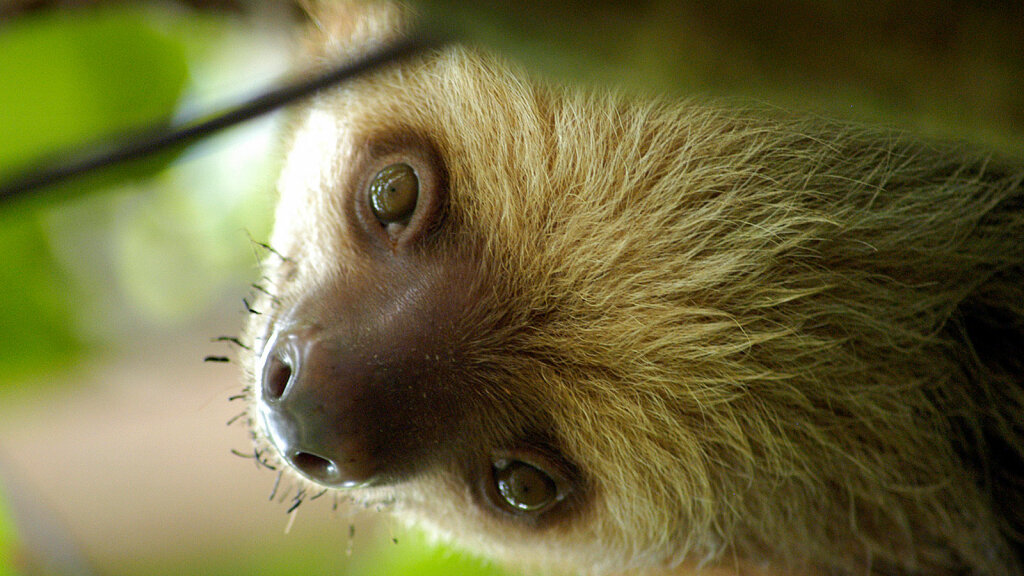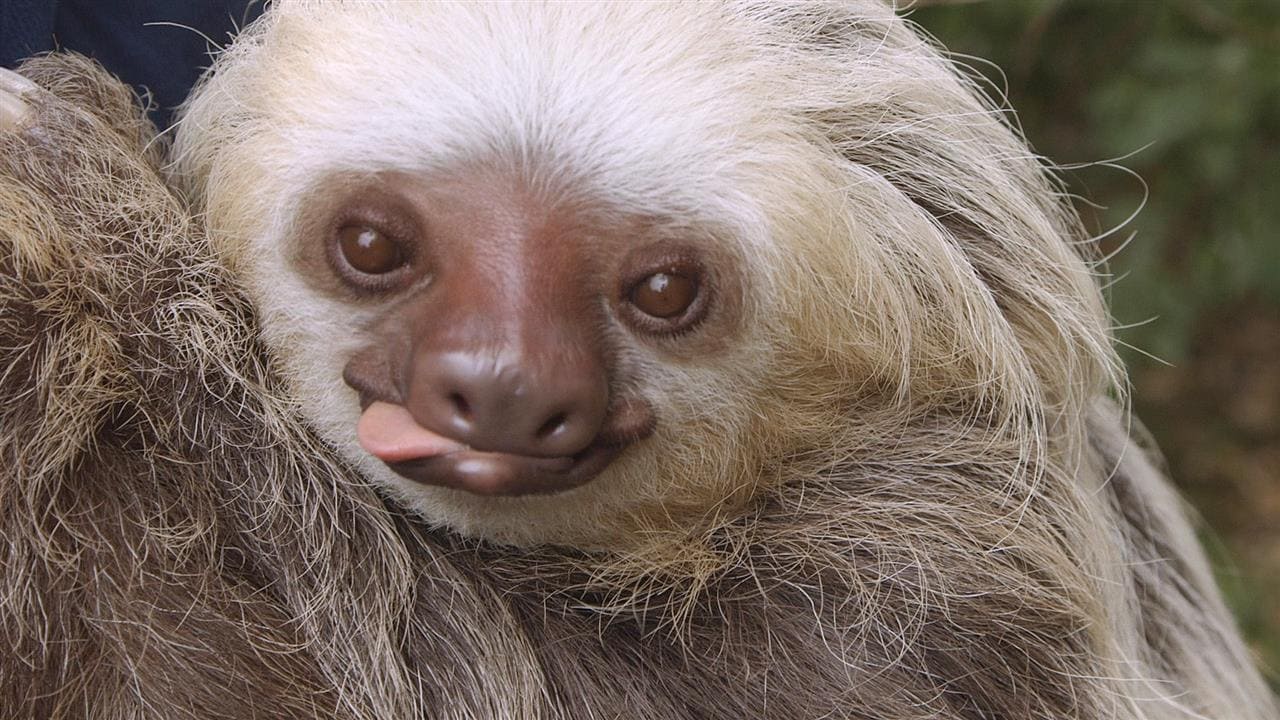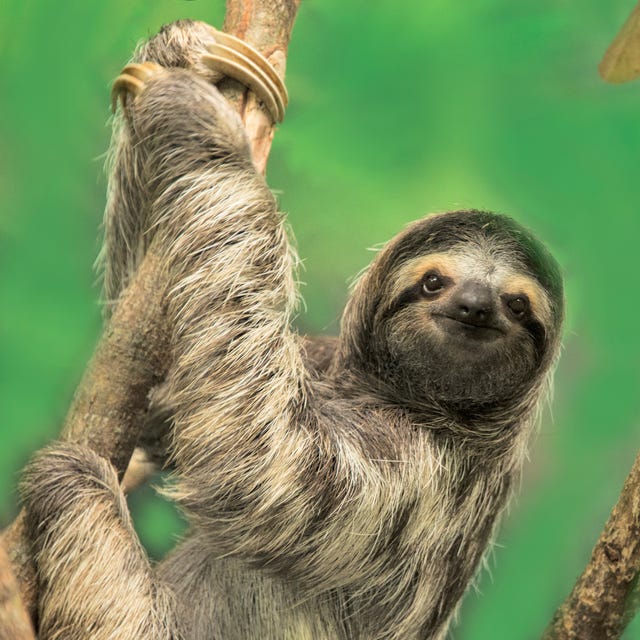A Sloths Lifestyle


Tree sloths are among the most emblematic tree-dwelling mammals. However, they are best known for their pokey demeanor rather than the fact that they spend the majority of their lives in trees munching leaves. The lifestyle of the Sloth has so many lessons for human survival in the 21st century. If we continue to promote the dominant paradigm of infinite growth with our 'faster, bigger, stronger' behavior; the economic system pushing mass-production, mass-consumption and a scientific, reductionist view of nature it is clear that we will. Sloth, (suborder Phyllophaga), tree-dwelling mammal noted for its slowness of movement. All five living species are limited to the lowland tropical forests of South and Central America, where they can be found high in the forest canopy sunning, resting, or feeding on leaves. Three-toed sloths are some of the slowest and seemingly laziest creatures in the world. Instead of evolving to eat more, they evolved to do less.

Our editors will review what you’ve submitted and determine whether to revise the article.
Join Britannica's Publishing Partner Program and our community of experts to gain a global audience for your work!
Sloth, (suborder Phyllophaga), tree-dwelling mammal noted for its slowness of movement. All five living species are limited to the lowland tropical forests of South and Central America, where they can be found high in the forest canopy sunning, resting, or feeding on leaves. Although two-toed sloths (family Megalonychidae) are capable of climbing and positioning themselves vertically, they spend almost all of their time hanging horizontally, using their large hooklike extremities to move along branches and vines. Three-toed sloths (family Bradypodidae) move in the same way but often sit in the forks of trees rather than hanging from branches.
What kind of animal is a sloth?
Sloths are mammals. They are part of the order Pilosa, which is also home to anteaters. Together with armadillos, sloths and anteaters form the magnorder Xenarthra.
How many types of sloths are there?
A total of five species of sloths exist: the pygmy three-toed sloth, the maned sloth, the pale-throated three-toed sloth, the brown-throated three-toed sloth, and Linnaeus's two-toed sloth. All sloths are either two-toed or three-toed.
Where do sloths live?
A Sloths Lifestyle Facts
Sloths live in the lowland tropical areas of South and Central America. They spend most of their life in the forest canopy. Two-toed sloths tend to hang horizontally from branches, while three-toed sloths often sit in the forks of trees.
What do sloths eat?
Sloths are omnivores. Because they spend most of their time in trees, they like to munch on leaves, twigs, flowers, and other foliage, though some species may eat insects and other small animals.

Why are sloths so slow?
Sloths are slow because of their diet and metabolic rate. They eat a low-calorie diet consisting exclusively of plants, and they metabolize at a rate that is only 40–45 percent of what is expected for mammals of their weight. Sloths must move slowly to conserve energy.
Sloths have long legs, stumpy tails, and rounded heads with inconspicuous ears. Although they possess colour vision, sloths’ eyesight and hearing are not very acute; orientation is mainly by touch. The limbs are adapted for suspending the body rather than supporting it. As a result, sloths are completely helpless on the ground unless there is something to grasp. Even then, they are able only to drag themselves along with their claws. They are surprisingly good swimmers. Generally nocturnal, sloths are solitary and are aggressive toward others of the same sex.
Sloths have large multichambered stomachs and an ability to tolerate strong chemicals from the foliage they eat. The leafy food is digested slowly; a fermenting meal may take up to a week to process. The stomach is constantly filled, its contents making up about 30 percent of the sloth’s weight. Sloths descend to the ground at approximately six-day intervals to urinate and defecate (see Sidebar: A moving habitat). Physiologically, sloths are heterothermic—that is, they have imperfect control over their body temperature. Normally ranging between 25 and 35 °C (77 and 95 °F), body temperature may drop to as low as 20 °C (68 °F). At this temperature the animals become torpid. Although heterothermicity makes sloths very sensitive to temperature change, they have thick skin and are able to withstand severe injuries.
All sloths were formerly classified in the same family (Bradypodidae), but two-toed sloths have been found to be so different from three-toed sloths that they are now classified in a separate family (Megalonychidae).
Three-toed sloths
The three-toed sloth (family Bradypodidae) is also called the ai in Latin America because of the high-pitched cry it produces when agitated. All four species belong to the same genus, Bradypus, and the coloration of their short facial hair bestows them with a perpetually smiling expression. The brown-throated three-toed sloth (B. variegatus) occurs in Central and South America from Honduras to northern Argentina; the pale-throated three-toed sloth (B. tridactylus) is found in northern South America; the maned sloth (B. torquatus) is restricted to the small Atlantic forest of southeastern Brazil; and the pygmy three-toed sloth (B. pygmaeus) inhabits the Isla Escudo de Veraguas, a small Caribbean island off the northwestern coast of Panama.
Although most mammals have seven neck vertebrae, three-toed sloths have eight or nine, which permits them to turn their heads through a 270° arc. The teeth are simple pegs, and the upper front pair are smaller than the others; incisor and true canine teeth are lacking. Adults weigh only about 4 kg (8.8 pounds), and the young weigh less than 1 kg (2.2 pounds), possibly as little as 150–250 grams (about 5–9 ounces) at birth. (The birth weight of B. torquatus, for example, is only 300 grams [about 11 ounces].) The head and body length of three-toed sloths averages 58 cm (23 inches), and the tail is short, round, and movable. The forelimbs are 50 percent longer than the hind limbs; all four feet have three long, curved sharp claws. Sloths’ coloration makes them difficult to spot, even though they are very common in some areas. The outer layer of shaggy long hair is pale brown to gray and covers a short, dense coat of black-and-white underfur. The outer hairs have many cracks, perhaps caused by the algae living there. The algae give the animals a greenish tinge, especially during the rainy season. Sexes look alike in the maned sloth, but in the other species males have a large patch (speculum) in the middle of the back that lacks overhair, thus revealing the black dorsal stripe and bordering white underfur, which is sometimes stained yellow to orange. The maned sloth gets its name from the long black hair on the back of its head and neck.
Real Life Sloth
Three-toed sloths, although mainly nocturnal, may be active day or night but spend only about 10 percent of their time moving at all. They sleep either perched in the fork of a tree or hanging from a branch, with all four feet bunched together and the head tucked in on the chest. In this posture the sloth resembles a clump of dead leaves, so inconspicuous that it was once thought these animals ate only the leaves of cecropia trees because in other trees it went undetected. Research has since shown that they eat the foliage of a wide variety of other trees and vines. Locating food by touch and smell, the sloth feeds by hooking a branch with its claws and pulling it to its mouth. Sloths’ slow movements and mainly nocturnal habits generally do not attract the attention of predators such as jaguars and harpy eagles. Normally, three-toed sloths are silent and docile, but if disturbed they can strike out furiously with the sharp foreclaws.
Reproduction is seasonal in the brown- and pale-throated species; the maned sloth may breed throughout the year. Reproduction in pygmy three-toed sloths, however, has not yet been observed. A single young is born after less than six months’ gestation. Newborn sloths cling to the mother’s abdomen and remain with the mother until at least five months of age. Three-toed sloths are so difficult to maintain in captivity that little is known about their breeding behaviour and other aspects of their life history.
- related topics
Fun Facts for Kids
A Sloths Lifestyle Magazine
- The long and coarse fur of this animal is normally light brown, though may seem to be green because of blue-green algae, growing there.
- At a few weeks old, infant sloths get algae colonies into their fur from their mothers. Algae, growing on their fur, do not occur anywhere else. These animals allow algae to live in their fur, providing it with required moisture. Algae, in turn, serve as camouflage, helping them escape predators.
- Males of this species are identified by a bright yellow or orange colored marking between their shoulders. In this patch, they possess scent marking glands, which are used to attract receptive females.
- These sloths practice two types of resting: 'awake-alert' - this is when they rest with open eyes and blink; and 'behavioral sleep' – this is when they are suspended from a tree with their eyes closed.
- These accomplished swimmers drop themselves off branches into rivers to swim. They are known to use breaststroke style, just like humans.
- Muscles make up only 25% of a sloth's body. So when it's cold, the animal cannot shiver in order to warm up.
- Due to a specific shape of its mouth, the Brown-throated sloth seems to smile constantly. The flexible head of this animal can rotate up to 90 degrees.